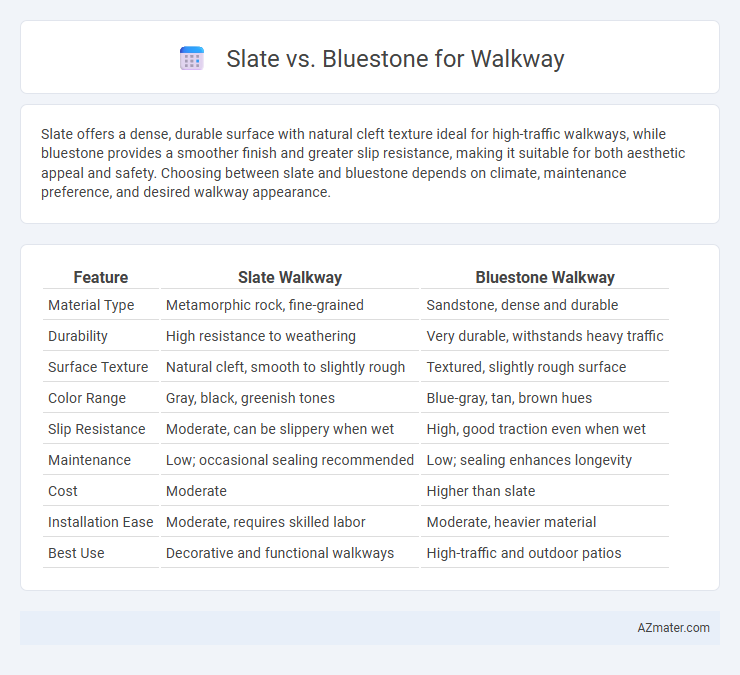Slate offers a dense, durable surface with natural cleft texture ideal for high-traffic walkways, while bluestone provides a smoother finish and greater slip resistance, making it suitable for both aesthetic appeal and safety. Choosing between slate and bluestone depends on climate, maintenance preference, and desired walkway appearance.
Table of Comparison
| Feature | Slate Walkway | Bluestone Walkway |
|---|---|---|
| Material Type | Metamorphic rock, fine-grained | Sandstone, dense and durable |
| Durability | High resistance to weathering | Very durable, withstands heavy traffic |
| Surface Texture | Natural cleft, smooth to slightly rough | Textured, slightly rough surface |
| Color Range | Gray, black, greenish tones | Blue-gray, tan, brown hues |
| Slip Resistance | Moderate, can be slippery when wet | High, good traction even when wet |
| Maintenance | Low; occasional sealing recommended | Low; sealing enhances longevity |
| Cost | Moderate | Higher than slate |
| Installation Ease | Moderate, requires skilled labor | Moderate, heavier material |
| Best Use | Decorative and functional walkways | High-traffic and outdoor patios |
Introduction to Slate and Bluestone Walkways
Slate walkways are crafted from fine-grained metamorphic rock, known for their durability, natural cleft texture, and rich color variations that enhance outdoor aesthetics. Bluestone walkways, made from dense sandstone, offer a smooth, non-slip surface with a unique blue-gray hue popular for both rustic and modern landscaping designs. Both materials provide robust, weather-resistant options ideal for creating elegant and long-lasting pathways.
Material Composition: Slate vs Bluestone
Slate consists primarily of fine-grained metamorphic rock formed from shale, featuring dense, layered mineral content that provides durability and natural slip resistance ideal for walkways. Bluestone, typically a sandstone or limestone variant, contains quartz, feldspar, and chert, offering a smoother texture with a slightly softer and more porous composition compared to slate. The mineral density in slate results in higher hardness and longevity, while bluestone's sedimentary origin contributes to its warm color tones and ease of cutting for custom walkway designs.
Visual Appeal and Color Variations
Slate offers a natural, rustic visual appeal with its textured surface and rich earth tones ranging from deep grays to greens and rusts, perfect for creating a classic or organic walkway look. Bluestone provides a smoother, more uniform appearance with subtle variations in blue, gray, and sometimes tan hues, lending a modern and elegant feel ideal for sophisticated landscape designs. Both materials feature durable stone characteristics but cater to distinct aesthetic preferences through their unique color palettes and surface finishes.
Durability and Longevity Comparison
Slate offers exceptional durability due to its dense, natural composition and resistance to weathering, making it ideal for long-lasting walkways. Bluestone, while also durable, is generally softer and more porous, which can lead to faster wear and potential surface erosion over time. Choosing slate ensures superior longevity and minimal maintenance in high-traffic outdoor applications.
Slip Resistance and Safety Factors
Slate offers excellent slip resistance due to its naturally rough, textured surface, making it a safer choice for walkways exposed to wet or icy conditions. Bluestone provides moderate slip resistance with a denser, smoother finish that can become slippery when wet unless treated with a non-slip sealant. Prioritizing slip resistance and safety factors, slate is often preferred for high-traffic outdoor walkways requiring durability and minimal maintenance.
Installation Process and Techniques
Slate walkways require careful cutting with wet saws and precise leveling due to their natural cleft surface, ensuring a durable and slip-resistant path. Bluestone installation involves setting uniformly cut slabs on a compacted base with mortar or sand joints, enabling smoother, more consistent surfaces. Both materials demand proper base preparation and attention to joint spacing to prevent shifting and ensure longevity.
Maintenance Requirements and Costs
Slate walkways demand regular sealing and occasional cleaning to prevent staining and delamination, with maintenance costs averaging $0.50 to $1.50 per square foot annually. Bluestone, known for its durability and denser composition, requires less frequent sealing and minimal cleaning, resulting in lower maintenance expenses typically around $0.25 to $0.75 per square foot each year. Long-term investment in Bluestone often proves more cost-effective due to its resistance to weathering and reduced upkeep needs compared to Slate.
Climate Suitability and Weather Resistance
Slate offers excellent climate suitability for walkways, particularly in regions with fluctuating temperatures, due to its natural ability to withstand freeze-thaw cycles without cracking. Bluestone is highly weather-resistant, performing well in both wet and dry conditions, and its dense composition reduces water absorption, minimizing damage from frost and ice. Both materials provide durable, low-maintenance options, but slate is preferred in colder climates while bluestone excels in areas with high moisture and heavy rainfall.
Environmental Impact and Sustainability
Slate for walkways offers durability and natural weather resistance, reducing the need for frequent replacement and minimizing material waste, thereby supporting sustainability goals. Bluestone, a dense and long-lasting sedimentary rock, is quarried with methods that can be environmentally intensive but is highly recyclable and requires little maintenance over time. Both materials contribute to eco-friendly landscaping when sourced responsibly, with slate's renewable extraction processes and bluestone's longevity helping reduce overall environmental impact in outdoor applications.
Cost Analysis: Slate vs Bluestone Walkway
Slate walkways generally cost between $15 and $30 per square foot, reflecting their durability and natural texture. Bluestone prices typically range from $20 to $40 per square foot, often influenced by its thickness and finishing options. Choosing between slate and bluestone depends on budget constraints and the desired aesthetic, with slate offering a more affordable yet sturdy alternative to the premium look and feel of bluestone.

Infographic: Slate vs Bluestone for Walkway
 azmater.com
azmater.com